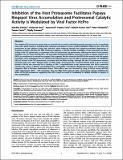Por favor, use este identificador para citar o enlazar a este item:
http://hdl.handle.net/10261/95944COMPARTIR / EXPORTAR:
 SHARE SHARE
 CORE
BASE CORE
BASE
|
|
| Visualizar otros formatos: MARC | Dublin Core | RDF | ORE | MODS | METS | DIDL | DATACITE | |

| Título: | Inhibition of the Host Proteasome Facilitates Papaya Ringspot Virus Accumulation and Proteosomal Catalytic Activity Is Modulated by Viral Factor HcPro |
Autor: | Sahana, Nandita; Kaur, Harpreet; Basavaraj; Tena, Fátima CSIC; Rakesh Kumar, Jain; Palukaitis, Peter; Canto, Tomás CSIC ORCID ; Praveen, Shelly | Fecha de publicación: | 27-dic-2012 | Editor: | Public Library of Science | Citación: | PLoS ONE 7(12): e52546 | Resumen: | [EN] The ubiquitin/26S proteasome system plays an essential role not only in maintaining protein turnover, but also in regulating many other plant responses, including plant–pathogen interactions. Previous studies highlighted different roles of the 20S proteasome in plant defense during virus infection, either indirectly through viral suppressor-mediated degradation of Argonaute proteins, affecting the RNA interference pathway, or directly through modulation of the proteolytic and RNase activity of the 20S proteasome, a component of the 20S proteasome, by viral proteins, affecting the levels of viral proteins and RNAs. Here we show that MG132, a cell permeable proteasomal inhibitor, caused an increase in papaya ringspot virus (PRSV) accumulation in its natural host papaya (Carica papaya). We also show that the PRSV HcPro interacts with the papaya homologue of the Arabidopsis PAA (a1 subunit of the 20S proteasome), but not with the papaya homologue of Arabidopsis PAE (a5 subunit of the 20S proteasome), associated with the RNase activity, although the two 20S proteasome subunits interacted with each other. Mutated forms of PRSV HcPro showed that the conserved KITC54 motif in the N-terminal domain of HcPro was necessary for its binding to PAA. Co-agroinfiltration assays demonstrated that HcPro expression mimicked the action of MG132, and facilitated the accumulation of bothtotal ubiquitinated proteins and viral/non-viral exogenous RNA in Nicotiana benthamiana leaves. These effects were not observed by using an HcPro mutant (KITS54),which impaired the HcPro – PAA interaction. Thus, the PRSV HcPro interacts with a proteasomal subunit, inhibiting the action of the 20S proteasome, suggesting that HcPro might be crucial for modulating its catalytic activities in support of virus accumulation | Versión del editor: | http://dx.doi.org/10.1371/journal.pone.0052546 | URI: | http://hdl.handle.net/10261/95944 | DOI: | 10.1371/journal.pone.0052546 | ISSN: | 1932-6203 |
| Aparece en las colecciones: | (CIB) Artículos |
Ficheros en este ítem:
| Fichero | Descripción | Tamaño | Formato | |
|---|---|---|---|---|
| PLOS-ONE Tomás Canto pone.0052546-1.pdf | 2,71 MB | Adobe PDF |  Visualizar/Abrir |
CORE Recommender
PubMed Central
Citations
21
checked on 29-mar-2024
SCOPUSTM
Citations
49
checked on 12-abr-2024
WEB OF SCIENCETM
Citations
44
checked on 24-feb-2024
Page view(s)
322
checked on 19-abr-2024
Download(s)
246
checked on 19-abr-2024
Google ScholarTM
Check
Altmetric
Altmetric
Artículos relacionados:
NOTA: Los ítems de Digital.CSIC están protegidos por copyright, con todos los derechos reservados, a menos que se indique lo contrario.
